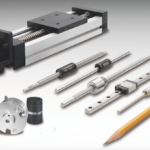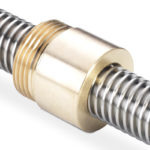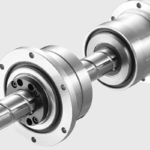Knowing the differences between the several kinds of roller screws can help determine the best fit for an application.
By Michael Boudreau, P.Eng. • Application Engineering Manager | Rollvis S.A.
Planetary roller screws — also called satellite roller screws — have long been the primary choice for applications that involve heavier loads and higher forces than traditional ball screws can withstand, or that require better speed and positioning accuracy than hydraulic cylinders can provide. But some roller screw designs (specifically, recirculating roller screws) are also well-suited for high-precision applications, where resolution and positioning accuracy are of utmost importance.
Knowing the differences between traditional planetary roller screws and recirculating roller screws – which are a special variation of the planetary design – and looking at some examples of best-fit applications for each can help determine the right one for your application.
Planetary roller screws
Planetary, or satellite, roller screws are the most familiar design, consisting of a screw, nut, and satellite rollers, all of which have triangular threads with matching helix angles. The screw and nut have multiple-start threads, while the rollers have a single-start thread.

The nut has a roller ring and a geared wheel at each end, and the ends of each roller have cylindrical pivots and gear teeth. The pivots of the rollers are mounted in the holes of the roller ring, ensuring the rollers remain equidistant. The gear teeth on the ends of the rollers engage with the gear wheels at each end of the nut, which guide the rollers parallel to the axis of the screw. Note that in this design, there is no axial movement between the rollers and the nut, so the rollers don’t need to be recirculated.
The curvature of the rollers gives them much larger contact areas than that of the balls in a ball screw, and roller screws typically have more contact points than ball screws. Together, these features allow planetary roller screws to withstand much higher loads than ball screws. This higher load-carrying capacity is often cited as their main advantage, but having larger contact areas also gives roller screws better rigidity and less deflection than similarly sized ball screws, making planetary roller screws ideal for grinding applications. And despite this large contact area, the crowned profile of the rollers means that efficiency is nearly the same as that of a ball screw.
Recirculating roller screws
Recirculating roller screws are a special variant of the standard planetary design, with the same primary components; a screw, nut, and rollers. Like the planetary design, the screw and nut have threads with a helix angle, but for recirculating designs, the screw and nut have only a single- or double-start thread. And instead of threads, the rollers have circular grooves perpendicular to the axis of the screw, so they need to be “recirculated” after each turn around the shaft.
In the recirculating design, the rollers are held in a cage, with each slot in the cage being slightly longer than the roller length. Because the rollers are grooved rather than threaded, when the screw shaft turns the rollers are axially displaced in the nut along the length of the slotted cage.
Once a roller makes a complete revolution around the screw, cams at each end of the nut disengage the roller from the screw shaft and return it to its initial position, but advanced axially by the amount of the screw lead.
Roller-screw performance and applications
With rollers as the load-bearing elements, both traditional planetary roller screws and recirculating roller screws provide high load capacities and excellent rigidity. The key difference is that recirculating designs – because they require only a single- or double-start screw thread – can be manufactured with fine leads, even with large screw diameters. Some recirculating designs even have fractional-millimeter leads (0.25 mm, for example). And with a fine lead, the required input torque is minimized. The trade off, however, is that recirculating roller screws have lower speed and acceleration capabilities than traditional planetary designs.

Planetary roller screws are used wherever extremely high loads and high rigidity are required, such as pressing and welding applications. And machine builders are more frequently choosing planetary roller screws over hydraulic systems, to reduce system complexity and maintenance costs.
Recirculating roller screws are commonly used where micron-level positioning is required, such as in semiconductor manufacturing equipment. And they’re often the best choice for applications that combine the need for micron-level positioning with high stiffness and rigidity, such as in grinding equipment or for fine-tuning the focus on telescope lenses.
Planetary roller screws — whether standard, recirculating, or other special variants — are known as problem-solvers in challenging motion applications. They excel in applications that require highly dynamic operation (high speeds combined with high load capacities and good positioning accuracy) performance criteria that traditional ball screws and hydraulic cylinders have difficulty meeting.
Planetary versus satellite roller screw
The term “planetary” roller screw comes from the fact that when the screw shaft turns, the rollers spin on their axes as they orbit around the nut, much like planets orbiting around their sun.
The first patent for a roller screw was issued in France in the 1940s, and in French, the word “satellite” is used to describe the movement of the rollers around the screw. This is why planetary roller screws are sometimes referred to as “satellite” roller screws.
More rollers, more contact, and higher efficiency? In both standard and recirculating roller screws, the flanks of the screw and nut thread profiles are purely triangular, with flat surfaces. But the flanks of the roller threads (planetary designs) or grooves (recirculating designs) are crowned.
This is an important design feature because it allows the rollers to experience rolling rather than sliding contact. This rolling contact gives both traditional and recirculating roller screw designs high efficiencies, despite the large number of contact points on the rollers.
Rollvis S.A.
rollvis.com







Leave a Reply
You must be logged in to post a comment.